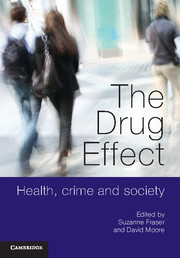Book contents
- Frontmatter
- Contents
- List of contributors
- Acknowledgements
- Introduction
- Part 1 Drug use as social and cultural practice
- Part 2 Drugs, health and the medicalisation of addiction
- Part 3 Drugs, crime and the law
- 9 Court-ordered treatment, neoliberalism and Homo economicus
- 10 Cannabis in cultural and legal limbo
- 11 Drugs, crime and the law in Australia
- 12 Reconceptualising harm reduction in prisons
- 13 Possessed
- Index
- References
9 - Court-ordered treatment, neoliberalism and Homo economicus
from Part 3 - Drugs, crime and the law
- Frontmatter
- Contents
- List of contributors
- Acknowledgements
- Introduction
- Part 1 Drug use as social and cultural practice
- Part 2 Drugs, health and the medicalisation of addiction
- Part 3 Drugs, crime and the law
- 9 Court-ordered treatment, neoliberalism and Homo economicus
- 10 Cannabis in cultural and legal limbo
- 11 Drugs, crime and the law in Australia
- 12 Reconceptualising harm reduction in prisons
- 13 Possessed
- Index
- References
Summary
The practice of courts ordering drug-using offenders to attend treatment has become a striking feature of criminal justice systems around the world. Although this development is in many respects of relatively recent origin, penal or criminal justice responses to drugs have a much longer history. In late nineteenth-century Britain, for example, legislation provided powers to the courts for the compulsory detention of criminal inebriates in specialist reformatories. And, of course, the global drug control regime that was constructed in the first two decades of the twentieth century has been based since its inception on the use of the criminal law as a tool for regulating the manufacture, distribution and possession of ‘dangerous drugs’. In the US, for example, the Harrison Narcotics Act of 1914, one of the earliest pieces of national ‘prohibition’ legislation, provided for fines of up to $2000 and prison sentences of up to five years for violations of its regulations.
The connection, then, between drugs and criminal justice is not a recent invention. It is embedded in the foundations of drug control. Nevertheless, the type of fusion of drug treatment and criminal justice that I describe in this chapter represents a new line of development in this longer story. Perhaps the first step along this road was Robert Dupont's ill-starred ‘Operation Tripwire’ proposal in 1977 in the US. Although never implemented, its key components – the use of drug testing as a screening tool and for the monitoring of compliance, coupled with the systematic integration of treatment and criminal justice – set the template for much of what followed and indeed continues to do so. Initiatives began to emerge in the 1980s, gathering pace in the 1990s, but it is in the first decade of the twenty-first century that the fusion of drug treatment and criminal justice has become a genuinely worldwide phenomenon.
- Type
- Chapter
- Information
- The Drug EffectHealth, Crime and Society, pp. 155 - 170Publisher: Cambridge University PressPrint publication year: 2011
References
- 4
- Cited by



